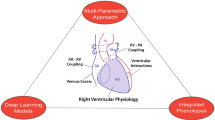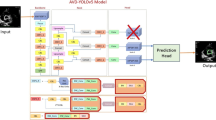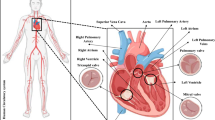Abstract
An essential element of cardiac function, the mitral valve (MV) ensures proper directional blood flow between the left heart chambers. Over the past two decades, computational simulations have made marked advancements toward providing powerful predictive tools to better understand valvular function and improve treatments for MV disease. However, challenges remain in the development of robust means for the quantification and representation of MV leaflet geometry. In this study, we present a novel modeling pipeline to quantitatively characterize and represent MV leaflet surface geometry. Our methodology utilized a two-part additive decomposition of the MV geometric features to decouple the macro-level general leaflet shape descriptors from the leaflet fine-scale features. First, the general shapes of five ovine MV leaflets were modeled using superquadric surfaces. Second, the finer-scale geometric details were captured, quantified, and reconstructed via a 2D Fourier analysis with an additional sparsity constraint. This spectral approach allowed us to easily control the level of geometric details in the reconstructed geometry. The results revealed that our methodology provided a robust and accurate approach to develop MV-specific models with an adjustable level of spatial resolution and geometric detail. Such fully customizable models provide the necessary means to perform computational simulations of the MV at a range of geometric accuracies in order to identify the level of complexity required to achieve predictive MV simulations.
















Similar content being viewed by others
Abbreviations
- MV:
-
Mitral valve
- MVR:
-
Mitral valve regurgitation
- TEE:
-
Trans-esophageal echocardiograms
- Micro-CT:
-
Micro-computed tomography
- US:
-
Ultrasound
- CLHS:
-
Cylindrical left heart simulator
- PM:
-
Papillary muscle
- FFT:
-
Fast Fourier transform
- NUFFT:
-
Non-uniform fast Fourier transform
- LASSO:
-
Least absolute shrinkage and selection operator
- \(\left\| \right\| _2 \) :
-
\(\hbox {L}^{2}\) norm
References
Acker MA et al (2014) Mitral-valve repair versus replacement for severe ischemic mitral regurgitation. New Engl J Med 370:23–32
Ayoub S, Ferrari G, Gorman RC, Gorman JH, Schoen FJ, Sacks MS (2016) Heart valve biomechanics and underlying mechanobiology. Compr Physiol 6(4):1743–1780
Ayoub S, Lee CH, Driesbaugh KH, Anselmo W, Hughes TC, Ferrari G, Gorman RC, Gorman JH, Sack MS Heart valve regulation of valve interstitial cell homeostasis by mechanical deformation: implications for heart valve disease and surgical repair. J Royal Soc Interface (in press)
Ban E et al (2017) Collagen organization in facet capsular ligaments varies with spinal region and with ligament deformation. J Biomech Eng 139(7):071009
Bardinet E, Cohen LD, Ayache N (1996) Tracking and motion analysis of the left ventricle with deformable superquadrics. Med Image Anal 1:129–149
Barr AH (1981) Superquadrics and angle-preserving transformations. IEEE Comput Graph Appl 1:11–23
Beck A, Teboulle M (2009) A fast iterative shrinkage-thresholding algorithm for linear inverse problems. SIAM J Imaging Sci 2:183–202
Becker S, Bobin J, Candès EJ (2011) NESTA: a fast and accurate first-order method for sparse recovery. SIAM J Imaging Sci 4:1–39
Bernstein MA, Fain SB, Riederer SJ (2001) Effect of windowing and zero-filled reconstruction of MRI data on spatial resolution and acquisition strategy. J Magn Reson Imaging 14:270–280
Bloodworth CH, Pierce EL, Easley TF, Drach A, Khalighi AH, Toma M, Jensen MO, Sacks MS, Yoganathan AP (2017) Ex vivo methods for informing computational models of the mitral valve. Ann Biomed Eng 45(2):496–507
Bothe W, Miller DC, Doenst T (2013) Sizing for mitral annuloplasty: Where does science stop and voodoo begin? Ann Thorac Surg 95:1475–1483
Braunberger E et al (2001) Very long-term results (more than 20 years) of valve repair with carpentier’s techniques in nonrheumatic mitral valve insufficiency. Circulation 104:I8–11
Chandran KB (2010) Role of computational simulations in heart valve dynamics and design of valvular prostheses. Cardiovasc Eng Technol 1:18–38. doi:10.1007/s13239-010-0002-x
Choi HI, Choi SW, Moon HP (1997) Mathematical theory of medial axis transform. Pac J Math 181:57–88
Choi A, Rim Y, Mun JS, Kim H (2014) A novel finite element-based patient-specific mitral valve repair: virtual ring annuloplasty. Bio-med Mater Eng 24:341–347
Cochran RP, Kunzelman KS, Chuong CJ, Sacks MS, Eberhart RC (1991) Nondestructive analysis of mitral valve collagen fiber orientation. ASAIO Trans 37:M447–M448
d’Arcy J, Prendergast B, Chambers J, Ray S, Bridgewater B (2011) Valvular heart disease: the next cardiac epidemic. Heart 97:91–93
David TE, Armstrong S, McCrindle BW, Manlhiot C (2013) Late outcomes of mitral valve repair for mitral regurgitation due to degenerative disease. Circulation. doi:10.1161/CIRCULATIONAHA.112.000699
Deja MA et al (2012) Influence of mitral regurgitation repair on survival in the surgical treatment for ischemic heart failure trial. Circulation 125:2639–2648
Desai M, Jellis C, Yingchoncharoen T (2015) An atlas of mitral valve imaging. Springer, Berlin
Drach A et al (2015) Population-averaged geometric model of mitral valve from patient-specific imaging data. J Med Dev 9:030952
Drach A et al (2017) A comprehensive pipeline for multi-resolution modeling of the mitral valve: validation. computational efficiency, and predictive capability. Int J Numer Methods Biomed Eng. doi:10.1002/cnm.2921
Eck M, DeRose T, Duchamp T, Hoppe H, Lounsbery M, Stuetzle W (1995) Multiresolution analysis of arbitrary meshes. In: Proceedings of the 22nd annual conference on Computer graphics and interactive techniques. ACM, pp 173–182
Enriquez-Sarano M, Sundt TM (2010) Early surgery is recommended for mitral regurgitation. Circulation 121:804–812
Enriquez-Sarano M, Akins CW, Vahanian A (2009) Mitral regurgitation. Lancet 373:1382–1394
Fan R, Sacks MS (2014) Simulation of planar soft tissues using a structural constitutive model: finite element implementation and validation. J Biomech 47:2043–2054
Fedak PW, McCarthy PM, Bonow RO (2008) Evolving concepts and technologies in mitral valve repair. Circulation 117:963–974
Gottlieb D, Shu C-W (1997) On the Gibbs phenomenon and its resolution. SIAM Rev 39:644–668
Greengard L, Lee J-Y (2004) Accelerating the nonuniform fast fourier transform. SIAM Rev 46:443–454
Iung B, Vahanian A (2014) Epidemiology of acquired valvular heart disease. Can J Cardiol 30:962–970
Jaklic A, Leonardis A, Solina F (2013) Segmentation and recovery of superquadrics, vol 20. Springer, New York
Kaneko T, Cohn LH (2014) Mitral valve repair. Circ J Off J Jpn Circ Soc 78:560–566. doi:10.1253/circj.cj-14-0069
Khalighi AH (2015) The mitral valve computational anatomy and geometry analysis. The University of Texas at Austin, Austin
Khalighi AH et al (2015) A comprehensive framework for the characterization of the complete mitral valve geometry for the development of a population-averaged model. In: Functional imaging and modeling of the heart. Springer, Berlin, pp 164–171
Khalighi AH et al (2016) Stochastic models of the mitral valve chordae tendineae for high-fidelity simulations. In: 2016 BMES Annual Meeting, Biomedical Engineering Society
Khalighi AH, Drach A, Bloodworth CH, Pierce EL, Yoganathan AP, Gorman RC, Gorman JH, Sacks MS (2017) Mitral valve chordae tendineae: topological and geometrical characterization. Ann Biomed Eng 45(2):378–393
Kheradvar A et al (2015) Emerging trends in heart valve engineering: part I. Solutions for future. Ann Biomed Eng 43:833–843
Kunzelman KS, Cochran RP, Chuong C, Ring WS, Verrier ED, Eberhart RD (1993) Finite element analysis of the mitral valve. J Heart Valve Dis 2:326–340
Lee CH, Rabbah JP, Yoganathan AP, Gorman RC, Gorman JH III, Sacks MS (2015) On the effects of leaflet microstructure and constitutive model on the closing behavior of the mitral valve. Biomech Model Mechanobiol. doi:10.1007/s10237-015-0674-0
Lim KH, Yeo JH, Duran CM (2005) Three-dimensional asymmetrical modeling of the mitral valve: a finite element study with dynamic boundaries. J Heart Valve Dis 14:386–392
Lorensen WE, Cline HE (1987) Marching cubes: a high resolution 3D surface construction algorithm. In: ACM siggraph computer graphics, vol 4. ACM, pp 163–169
Lounsbery M, DeRose TD, Warren J (1997) Multiresolution analysis for surfaces of arbitrary topological type. ACM Trans Graph (TOG) 16:34–73
Maisano F, Redaelli A, Soncini M, Votta E, Arcobasso L, Alfieri O (2005) An annular prosthesis for the treatment of functional mitral regurgitation: finite element model analysis of a dog bone—shaped ring prosthesis. Ann Thorac Surg 79:1268–1275
Malladi R, Sethian JA (1995) Image processing via level set curvature flow. Proc Natl Acad Sci 92:7046–7050
McCarthy KP, Ring L, Rana BS (2010) Anatomy of the mitral valve: understanding the mitral valve complex in mitral regurgitation. Eur Heart J Cardiovasc Imaging 11:i3–i9
Millington-Sanders C, Meir A, Lawrence L, Stolinski C (1998) Structure of chordae tendineae in the left ventricle of the human heart. J Anat 192:573–581
O’Donoghue B, Candes E (2015) Adaptive restart for accelerated gradient schemes. Found Comput Math 15:715–732
Parikh N, Boyd S (2013) Proximal algorithms. Found Trends Optim 1:123–231
Park J, Metaxas D, Axel L (1996) Analysis of left ventricular wall motion based on volumetric deformable models and MRI-SPAMM. Med Image Anal 1:53–71
Pouch AM et al (2012) Semi-automated mitral valve morphometry and computational stress analysis using 3D ultrasound. J Biomech 45:903–907
Pouch AM et al (2014) Fully automatic segmentation of the mitral leaflets in 3D transesophageal echocardiographic images using multi-atlas joint label fusion and deformable medial modeling. Med Image Anal 18:118–129
Pouch AM et al (2015) Medially constrained deformable modeling for segmentation of branching medial structures: application to aortic valve segmentation and morphometry. Med Image Anal 26:217–231
Rabbah J-P, Saikrishnan N, Yoganathan AP (2013) A novel left heart simulator for the multi-modality characterization of native mitral valve geometry and fluid mechanics. Ann Biomed Eng 41:305–315. doi:10.1007/s10439-012-0651-z
Rankin J, Daneshmand M, Milano C, Gaca J, Glower D, Smith P (2013) Mitral valve repair for ischemic mitral regurgitation: review of current techniques. Heart Lung Vessel 5:246
Rausch MK, Bothe W, Kvitting JP, Swanson JC, Miller DC, Kuhl E (2012) Mitral valve annuloplasty: a quantitative clinical and mechanical comparison of different annuloplasty devices. Ann Biomed Eng 40:750–761. doi:10.1007/s10439-011-0442-y
Rausch MK, Famaey N, Shultz TO, Bothe W, Miller DC, Kuhl E (2013) Mechanics of the mitral valve: a critical review, an in vivo parameter identification, and the effect of prestrain. Biomech Model Mechanobiol 12:1053–1071. doi:10.1007/s10237-012-0462-z
Rego BV, Sacks MS (2017) A functionally graded material model for the transmural stress distribution of the aortic valve leaflet. J Biomech 54:88–95
Rego BV, Wells SM, Lee C-H, Sacks MS (2016) Mitral valve leaflet remodelling during pregnancy: insights into cell-mediated recovery of tissue homeostasis. J R Soc Interface 13:20160709
Rego BV, Ayoub A, Khalighi AH, Drach A, Gorman RC, Gorman JH, Sacks MS (2017) Alterations in mechanical properties and in vivo geometry of the mitral valve following myocardial infarction. In: Proceedings of the 2017 Summer Biomechanics, Bioengineering and Biotransport Conference, pp SB3C2017-1
Siefert AW et al (2013) In vitro mitral valve simulator mimics systolic valvular function of chronic ischemic mitral regurgitation ovine model. Ann Thorac Surg 95:825–830
Skallerud B, Prot V, Nordrum IS (2011) Modeling active muscle contraction in mitral valve leaflets during systole: a first approach. Biomech Model Mechanobiol 10:11–26. doi:10.1007/s10237-010-0215-9
Solina F, Bajcsy R (1990) Recovery of parametric models from range images: the case for superquadrics with global deformations. IEEE Trans Pattern Anal Mach Intell 12:131–147
Stevanella M et al (2011) Mitral valve patient-specific finite element modeling from cardiac MRI: application to an annuloplasty procedure. Cardiovasc Eng Technol 2:66–76
Sun W, Sacks MS (2005) Finite element implementation of a generalized Fung-elastic constitutive model for planar soft tissues. Biomech Model Mechanobiol 4:190–199
Terzopoulos D, Metaxas D (1990) Dynamic 3D models with local and global deformations: deformable superquadrics. In: Third International Conference on Computer Vision, Proceedings, 1990. IEEE, pp 606–615
Thom T et al (2006) Heart disease and stroke statistics—2006 update: a report from the American Heart Association Statistics Committee and Stroke Statistics Subcommittee. Circulation 113:e85–e151
Tibayan FA et al (2003) Geometric distortions of the mitral valvular-ventricular complex in chronic ischemic mitral regurgitation. Circulation 108:II-116–II-121
Tibshirani R (1996) Regression shrinkage and selection via the lasso. J R Stat Soc Ser B Methodol 58:267–288
Wang Q, Sun W (2013) Finite element modeling of mitral valve dynamic deformation using patient-specific multi-slices computed tomography scans. Ann Biomed Eng 41:142–153. doi:10.1007/s10439-012-0620-6
Weinberg EJ, Kaazempur-Mofrad MR (2006) A large-strain finite element formulation for biological tissues with application to mitral valve leaflet tissue mechanics. J Biomech 39:1557–1561
Yuan Y-X (2015) Recent advances in trust region algorithms. Math Progr 151:249–281
Zarei V, Liu CJ, Claeson AA, Akkin T, Barocas VH (2017) Image-based multiscale mechanical modeling shows the importance of structural heterogeneity in the human lumbar facet capsular ligament. Biomech Model Mechanobiol 16(4):1425–1438
Zhang W, Ayoub S, Liao J, Sacks MS (2016) A meso-scale layer-specific structural constitutive model of the mitral heart valve leaflets. Acta Biomater 32:238–255
Zhang S, Zarei V, Winkelstein BA , Barocas VH (2017) Multiscale mechanics of the cervical facet capsular ligament, with particular emphasis on anomalous fiber realignment prior to tissue failure. Biomech Model Mechanobiol. doi:10.1007/s10237-017-0949-8
Acknowledgements
Research reported in this publication was supported by National Heart, Lung, and Blood Institute of the National Institutes of Health under award number R01HL119297. The content is solely the responsibility of the authors and does not necessarily represent the official views of the National Institutes of Health. The authors gratefully acknowledge Bruno V. Rego for helpful discussions.
Author information
Authors and Affiliations
Corresponding author
Ethics declarations
Conflict of interest
The authors declare no conflict of interest.
Appendix
Appendix
1.1 Non-uniform data structure
We used an NUFFT algorithm that first interpolates (oversamples) the data on a dense Cartesian grid using truncated Gaussian kernels and then applies a standard FFT (Greengard and Lee 2004). This approach is a subset of NUFFT algorithms known as gridding algorithms. It has been shown that the effect of Gaussian kernels to interpolate the data on a regular grid can be removed using the convolution theorem. Thus, applying Gaussian gridding to perform Fourier analysis does not introduce interpolation errors if the data is uniformly distributed over a rectangular domain (one 2-D period). However, because MV attributes like the scalar fields representing geometric details are defined over irregular domains, gridding-based NUFFT algorithms fail unless the shape of the domain is accounted for.
1.2 Irregular domains
The deviation fields denoting the MV geometric details have free-form top and bottom boundaries (Fig. 16). These boundaries, corresponding to the MV annulus and free edge respectively, do not coincide with the top and bottom boundaries of the superquadric parametric domain. While the gridding step in the NUFFT algorithm oversamples the known function values on a periodic Cartesian grid, the data for deviation fields is defined on a subdomain of the entire periodic domain (Fig. 16a). This causes implicit zero-padding of the function values (Fig. 16b).
Applying FFT on the zero-padded data results in a Fourier analysis that is drastically different from the actual frequency content of the MV geometric details. This is due to the Gibbs phenomenon (Gottlieb and Shu 1997), which can pollute the entire spectrum with noise and is a direct artifact which is a direct artifact of a discontinuity (jump from actual function values to zero) at MV boundaries. Following this, all the high-frequency pollution in the reconstruction of geometric details can be attributed to the spectral leakage caused by the effect of windowing (Bernstein et al. 2001), which in our case models the MV boundaries. Expanding the bandwidth to attenuate the Gibbs phenomenon (Gottlieb and Shu 1997) causes two problems: (1) the computational cost of the 2-D Fourier analysis process increases quadratically with the number of frequencies and (2) faithful reconstruction of the geometric details becomes intractable as a result of the high-frequency components polluting the power spectrum. We addressed the latter issue by imposing sparsity penalization to the objective function for recovering the Fourier coefficients. Consequently, we were able to eliminate the spurious frequency components caused by the irregular boundaries and recover a clean spectrum through the implementation of iterative NUFFT penalized with the sparsity constraint Eq. (7). Applying fast harmonic analysis (NUFFT) with accelerated convergence (Sect. 2.4.2) enabled us to perform very fast image in-painting to recover the MV surface details in the 2D superquadric domain.
Rights and permissions
About this article
Cite this article
Khalighi, A.H., Drach, A., Gorman, R.C. et al. Multi-resolution geometric modeling of the mitral heart valve leaflets. Biomech Model Mechanobiol 17, 351–366 (2018). https://doi.org/10.1007/s10237-017-0965-8
Received:
Accepted:
Published:
Issue Date:
DOI: https://doi.org/10.1007/s10237-017-0965-8




